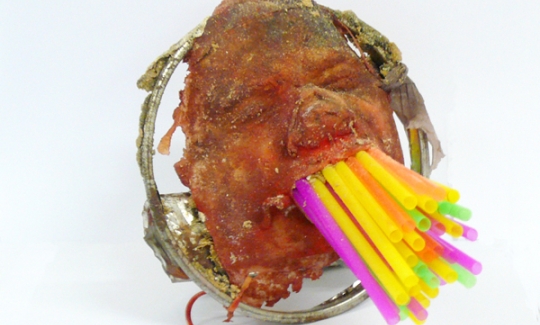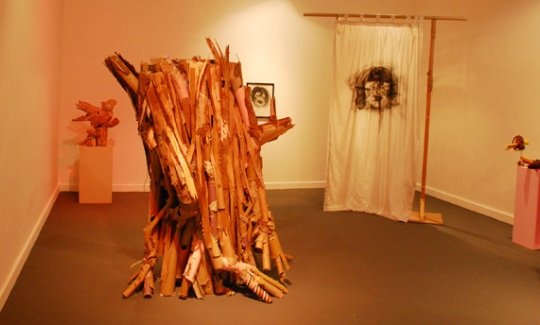Curator: Tal Yahas
Lior Waterman's work has a wild side, challenging politically correct codes of beauty and "good taste." The body, its different constituent parts and their substitutes appear as a central image in the majority of his work, reflecting a violent and chaotic worldview. The distorted body embodies a rejection of all worldly order: it is a fluid, hybrid, open body with breached boundaries, presented usually at its most "abject" - bleeding, salivating, carved up into parts, monstrous and ridiculous.
Although Waterman's artistic output usually consists of videos or performances, all of his work features a striking sculptural aspect. Waterman's sculpture is usually based on easily available and simple materials such as food stuffs, wax, wood parts and other found objects - which lose their original function and become sculptural objects through the artist's imagination and plastic sensitivity. The cheap materials - often used in a blunt way - signify parts of the body as an abject, permeable and impure arena, with the omnipresent potential of obsolescence. The artist's sharp visual humor manifests itself in his ability to view any material as metaphorical of the human body and the human face - as well as of low, barbaric human urges.
Elements of horror, ridicule and humor are combined in Waterman's work. Strategies of absurdity, nonsense and macabre humor make his dark, grotesque images funny. Ironically, it seems that this carnival of filth is, of all places, the grounds for a humanist potential: when everything is allowed, everybody - the perverse, the rejected, the ugly, the lame and anyone cast into the social and aesthetic margins - has a place. Subsequently, Waterman's art allows a moral discourse on a violent, oppressive reality. He chooses to react to this reality by stressing perversion and a lack of self control, and use the ensuing unease this engenders in his viewers to break social taboos and expose the mechanisms that keep the oppressive status quo. Besides its blunt cruelty, his work also sheds light on the marginal and on the anxieties foisted on it, revealing work that is often accompanied by that gentle compassion which comes from the "brotherhood of the oppressed," wading together through human detritus.


